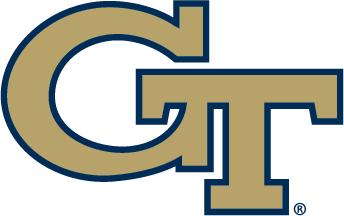April 2, 2015
By Matt Winkeljohn | The Good Word
– Megan Kurey’s Catch-22 is about to play out again as Georgia Tech’s women’s tennis team grinds toward the ACC tournament. She needs to rest her sore left foot, but it’s hard for her to help with that thing in an ice bucket.
So, she’s finding ways.
She had a big hand in the No. 36-ranked Yellow Jackets’ win Sunday at No. 17 Duke, and she’ll likely answer the call Friday and Saturday against No. 34 Virginia Tech and No. 22 Clemson.
The question will be, how many calls will she take? The more she plays, the more the foot aches. The less she plays, the more Tech is likely to struggle.
At Duke, she and teammate Alexa Anton-Ohlmeyer won their doubles match, but the Jackets dropped the doubles point and fell behind 3-1 before the junior from Alpharetta made her most meaningful impression of the season.
Playing just her 10th singles match since last May after taking off the summer and fall to give her left foot a fighting chance against plantar fasciitis, she handled Duke’s Chalena Scholl 7-5, 6-4 on court No. 6 to swing the match.
From there, Paige Hourigan and Anton-Ohlmeyer won on courts 2 and 5 to clinch Tech’s upset win in Durham.
“She wants to do well for the team so badly. That’ why it was great at Duke … that was a huge match,” said coach Rodney Harmon. “We were down 3-1, winning on Alexa’s court, and winning on Paige’s court, but she was in a dog fight.
“When Megan won, the momentum kind of switched our way [for good]. You should see the smile on her face. She was really, really happy, and then rooting really hard for the girls.”
Kurey had the benefit of rest going into Duke.
She did not play in last Friday’s 7-0 win over Wake Forest, and did not play in Tech’s 4-3 win over No. 32 Notre Dame the prior Sunday.
With a three-match ACC winning streak, the Jackets (8-6, 5-3 ACC) have climbed from No. 57 in the rankings to No. 36, and there is work to be done. Deciding how much of it Kurey will be a part of is an ongoing project as the Jackets this weekend finish a stretch that includes six ranked opponents out of seven.
“Now that we have eight [players], we can switch off. I know we have one of my teammates to step in for me, but of course I like to play,” she said. “The fall was really tough because I couldn’t play at all, couldn’t even practice.
“I think it also helped because when something is taken away you realize how much you enjoy it and how much it means to you. I made me want to get back out there that much more.”
The soreness in Kurey’s foot, caused by an inflamed tendon running under the back of the foot to the front, began late her freshman year. It was worse by the end of her sophomore season, which was a dandy.
She and junior teammate Kendal Woodard won the USTA/ITA Indoor National Championship in doubles, and Kurey was 12-7 in singles. By the end of the season, she was playing No. 2.
“At the end of last year, she was playing as such a high level and beating so many good players that to have to take the whole summer and fall off, it’s a struggle to get back to that level,” Harmon said. “She’s still not playing as well as she was then.
“Against Danielle Collins, who a couple weeks later won the NCAAs, she was up in the third when we played Virginia in the ACC tournament when we stopped the match. She saw the level at which she’s able to play, and then when you’re not able to play that’s frustrating.”
Kurey has tried a variety of treatments on her foot, gaining the most relief from a shock therapy procedure in August that broke up scar tissue. Still, it aches, especially after playing or training. She has spent quite a bit of time swimming, cycling, and working on an elliptical trainer.
“I swam all summer, because I wasn’t allowed to run. I like to run. That was a big adjustment,” she said. “At first, I wasn’t even allowed to kick [when swimming]. I was swimming with a buoy, paddling with my hands. I hated it. It was terrible.”
Kurey doesn’t have to be on the court to help, although that’s where she helps the most. She’s team captain, and not just for what she does in matches.
“She plays at a really high level every day in practice, more than some players who go up or down based on what’s going on with a relationship, or how much sleep they got, or how they did on a test,” Harmon explained. “Megan is more consistent. She’s very level, and she does it day after day after day.
“She shows up every day with a lunch pail. That in itself is the best form of leadership: deeds not words. If your work ethic is solid, then … that says a lot more than someone who talks a bunch.”
Kurey does the work. Sometimes, it’s different. She avoids drills that put more stress on her foot, and she doesn’t play all the matches – yet. In Friday’s home match against the Hokies, and Saturday’s contest at Clemson, she may not play both doubles and singles both days. That’s to be determined.
“I purposely sat her out when we played Notre Dame. I could have used her, but we were able to sneak through that match against a really good Notre Dame team,” Harmon said. “The girls played very well against Wake, but I did it knowing the Duke match was really big and the Virginia Tech and Clemson matches are big.
“I need her as much as I can get her down the stretch so I came up to her [at Duke] and I said, `Can you play two today?’ She said yes. If there’s one player who I know can not play a lot and then play at a really high level, she’s the one.”
In some ways, Kurey has helped by not playing.
“We can rest some players; it’s been an opportunity for others,” Harmon said. “Alexa and Alexis [Prokopuik] have played really, really well. Alexa clinched the match against Duke, and Alexis clinched the match against Notre Dame.”
Kurey prefers helping on the court. She said she probably will not compete during the summer, when the business major (operations and supply chain) will focus on an internship, practice and training.
She may not find complete relief for a while.
“When I got that procedure done the doctor said this is the most inflamed tendon I’ve ever seen. Mine was like triply inflamed on the ultrasound,” Kurey said. “I don’t think I’m all the way back yet, but I’ve definitely seen improvement. It really doesn’t hurt during a match. After the matches, it was really hurting.
“Maybe after I’m done with college tennis it will stop. It’s just something you have to push through. I know it’s going to hurt after I play.”
Get The Good Word in your e-mail box — it’s free! Just register here to get the latest features on Georgia Tech Athletics.
Also, make sure to follow Georgia Tech Athletics on Facebook and Twitter.









